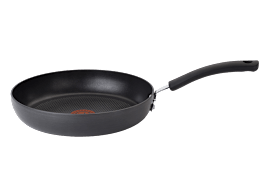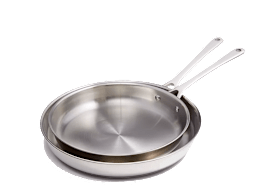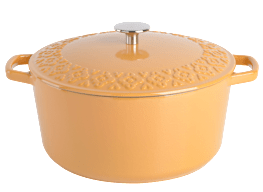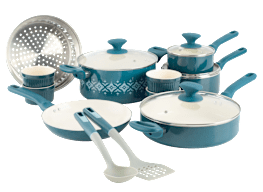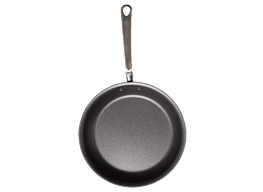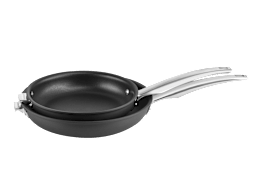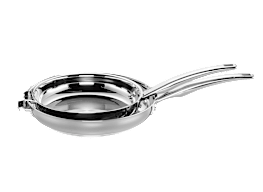Best Frying Pans for the Way You Cook
Nonstick, cast iron, stainless steel, or copper? Here’s how to decide what you need, plus the best pans from CR’s tests.
When you shop through retailer links on our site, we may earn affiliate commissions. 100% of the fees we collect are used to support our nonprofit mission. Learn more.

Frying pans are the workhorses of the kitchen, and if you’re like most home cooks, you probably own more than one—and more than one type. That makes sense because not every skillet is appropriate for every cooking task. And that’s why Consumer Reports tests several types of frying pans, including nonstick, cast iron, stainless steel, carbon steel, and copper.
“There are a few things to consider when you’re buying cookware, including how you cook, durability, and price,” says Lance Nitahara, an assistant professor at the Culinary Institute of America (CIA) in Hyde Park, N.Y. “On the low end of the price scale are nonstick and cast iron; copper is on the high end. But each does a different thing.”
Below, you’ll find advice on how to choose the right frying pan for how you cook, plus highlights of top-performing pans from CR’s tests, listed alphabetically and not by rank. You can see how all the pans we test perform in our frying pan ratings and learn more about the different types of pans in our cookware buying guide.
Nonstick Frying Pans
Best for: Scrambled or fried eggs, pancakes, fish, grilled cheese, and any other food that has a high probability of sticking to a typical pan. With nonstick skillets, these foods slide easily from frying pan to plate.
Stainless Steel Frying Pans
Best for: Almost any food that needs frying, browning, or searing. Because it’s ovenproof, stainless is also a good choice for foods that you start on the stovetop and then move to the oven to finish, like thick pork chops.
The details: Nitahara says that 95 percent of the pans used in the CIA’s teaching kitchens are stainless steel because they can take a lot of punishment. “The only time we don’t use them is on egg day, when we use nonstick,” he says. He adds that the shiny surface of a stainless pan makes it easy to see whether your food is browning.
In CR’s tests of stainless steel pans, we measure heating evenness by cooking pancakes, and we gauge how evenly a pan sautés by cooking potatoes until they’re tender. We also conduct a cleaning test to see how easy it is to remove cooked-on food. You’d think that all stainless pans would be about the same to clean, but our tests show that some require a lot more scrubbing than others.
Here are two recommended stainless steel pans from CR’s tests.
Cast-Iron Frying Pans
Best for: Almost any food that needs searing, including steak and burgers. Cast-iron pans are ovenproof, so you can use them to roast meats like beef or pork and to bake cornbread, deep-dish pizza, shepherd’s pie, and more. And they retain heat so well that they’re a good choice for deep-frying chicken, doughnuts, or other foods because they keep the oil at a constant temperature.
The details: Cast-iron frying pans are practically indestructible, and they’re handed down for generations in many families. That makes their typically low price even more attractive. And if well cared for, cast iron develops a patina that releases food almost as well as nonstick. But the pans are heavy, and you have to be patient when heating them up because they don’t come up to temperature fast. Once they do, however, they retain heat.
Our tests of coated and uncoated cast-iron pans show how versatile this cookware can be. We sear steaks, brown scallops, and bake cornbread to see how well a cast-iron pan works for home cooks. The best pans ace all these tests. We also judge how easy they are to clean. Because of the enamel coating, the coated pans are a bit easier to clean than the uncoated ones.
Here are two recommended cast-iron pans from our tests.
Copper Frying Pans
Best for: Delicate proteins like fish and seafood, melting sugar, making candy, and sauces.
The details: Copper frying pans are expensive, but they offer superb heat conductivity. That means they heat up quickly and cool down just as fast, giving you more control when you’re making something you have to monitor closely, like a caramel sauce. “They’re at the opposite end of the spectrum from cast iron,” Nitahara says. “Because it heats up and cools down quickly, you can bring a sauce right to the brink, then remove it from the heat before it breaks from the high heat.”
You can put a copper pan in the oven if you’re making a dessert like a tarte Tatin, but remember that copper can’t take the high heat of cast iron or stainless, so most manufacturers don’t recommend temperatures above 450 °F.
In our tests, we put copper skillets through the same heating evenness and sauté performance tests as stainless steel pans, which are also uncoated. We also cook foods that require controlled heat, including risotto, a gooey banana tarte Tatin, and melted white chocolate. All the copper pans perform well, Fisher says.
Here are two recommended copper pans from CR’s tests.
Carbon Steel Frying Pans
Best for: You can cook almost anything in these versatile pans that just get better over time. You can sear a thick piece of meat on the stovetop and then move the pan to the oven to finish. Carbon steel is good at high heat, and you can use these pans to fry eggs, fish, and make delicate sauces.
The details: While cast-iron frying pans are very familiar, home cooks typically know less about carbon steel pans. But they have all the advantages of cast iron and several more: They’re lighter, heat up faster and more evenly, and can cook a wider variety of foods. That’s why they’re the go-to pan in many restaurant kitchens. If you’ve ever eaten at a steakhouse, your meat was probably seared in a carbon steel frying pan.
In the labs, we put the carbon steel pans through the same tests as our cast-iron pans: heating evenness, baking, and browning. You have to keep carbon steel pans seasoned, like cast iron, but if you do, they soon develop a smooth patina that makes a pan as slick as nonstick, giving you even more cooking possibilities.
Here are two recommended carbon steel pans from CR’s tests.

















